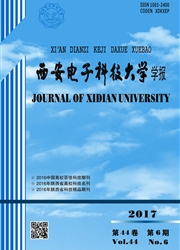

 中文摘要:
中文摘要:
为了改善单个分类器对雷达目标的识别性能,分别从差异性和准确率两个因素出发,提出了一种通过变换分类器选择集成对雷达目标识别的算法.首先,为了增加集成个体差异性,将个体分类器的预测标记作为变换的原始目标,将正确标记引入来代替变换中的目标均值,以此构造一个整数矩阵.通过将个体分类器的预测标记投影到经过正确标记的直线上,从而获得一组新的预测标记.然后,根据准确率和RPFmeasure这两种衡量分类器性能的准则,选择一些性能提高了的个体进行集成,以此保证个体分类器的准确率.最后,通过结合被选择的个体预测标记来改善对雷达目标的识别性能.对于UCI机器学习资源库中数据集和雷达一维距离像的实验结果表明,该算法能有效平衡个体差异性和个体准确率两个因素,并且相比单个分类器和其他集成方法,该方法提高了对雷达目标的识别准确率.
 英文摘要:
英文摘要:
Diversity among individuals and accuracy of individuals are two important factors to decide the ensemble generalization error, whereas enhancing diversity is at the cost of decreasing the accuracy of individuals. Hence, in order to improve the performance of radar target recognition classified by a single classifier, this paper introduces a new radar target recognition method based on the integer matrix linear transformation selective classifier ensemble that considers the balance of diversity and accuracy. Firstly, in order to enhance the diversity, the individual classifiers are considered as original targets of the linear transformation, and instead of the mean value of samples, the true labels are considered to construct an integer matrix. By projecting individual classifiers on the lines through the true labels, a set of new classifiers is obtained based on the project transformation. Secondly, according to two rules that measuring the performance of the classifier, the accuracy rate and RPF-measure, some new classifiers that can obtain better performance are selected to ensemble for increasing the accuracy of classifiers of an ensemble. Finally, the performance of radar target recognition is improved by combining the selected new classifiers. Experimental results of UCI datasets and the radar range profile indicate that the proposed method balances effectively diversity and accuracy, and that it can obtain better performance for radar target recognition compared with single classifier algorithms and other methods.
 同期刊论文项目
同期刊论文项目
 同项目期刊论文
同项目期刊论文
 Minimum-Entropy-Based Autofocus Algorithm for SAR Data Using Chebyshev Approximation and Method of S
Minimum-Entropy-Based Autofocus Algorithm for SAR Data Using Chebyshev Approximation and Method of S Unsupervised Change Detection in SAR Image Based on Gauss-Log Ratio Image Fusion and Compressed Proj
Unsupervised Change Detection in SAR Image Based on Gauss-Log Ratio Image Fusion and Compressed Proj Improve the performance of co-training by committee with refinement of class probability estimations
Improve the performance of co-training by committee with refinement of class probability estimations Unsupervised Classification of Fully Polarimetric SAR Images Based on Scattering Power Entropy and C
Unsupervised Classification of Fully Polarimetric SAR Images Based on Scattering Power Entropy and C Multivariate Compressive Sensing for Image Reconstruction in the Wavelet Domain: Using Scale Mixture
Multivariate Compressive Sensing for Image Reconstruction in the Wavelet Domain: Using Scale Mixture An efficient matrix bi-factorization alternative optimization method for low-rank matrix recovery an
An efficient matrix bi-factorization alternative optimization method for low-rank matrix recovery an 期刊信息
期刊信息
